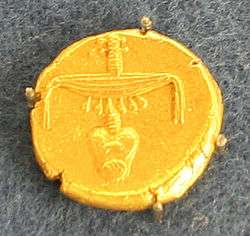The ancient Egyptian Gold hieroglyph is a member of the crowns, dress, staves hieroglyphs. Its major importance is as one of the Fivefold Titulary names of the Egyptian pharaoh, the Horus of Gold name.
The gold hieroglyph is used as a determinative in the names of precious metals,[1] and as an ideogram in nbw, "gold",[2] ("nbu"). The hieroglyph is an Egyptian language biliteral with the value of nb.
The hieroglyph is a large gold and pearl necklace.[3] Old Kingdom scenes show dwarfs metalworking the gold,[4] and "stringing the pearls of gold".[5]
Iconographic usage
Horus-of-Gold name
One of the older uses of the gold hieroglyph is for the Horus-of-Gold,
name. Also known as the
Golden Horus Name, this form of the pharaoh's name typically featured the image of a Horus falcon perched above /or beside the hieroglyph for gold.
The meaning of this particular title has been disputed. One belief is that it represents the triumph of Horus over his uncle Seth, as the symbol for gold can be taken to mean that Horus was "superior to his foes". Gold also was strongly associated in the ancient Egyptian mind with eternity, so this may have been intended to convey the pharaoh's eternal Horus name.
Similar to the
Fivefold Titulary Nebty name, this particular name typically was not framed by a cartouche or serekh. It always begins with the depiction of the horus falcon perched above a representation of the
sun-(hieroglyph).
Palermo Stone usage
In the 2392 BC (24th to 23rd century BC) Palermo Stone, one use of the gold hieroglyph is for the "first counting of gold". The sign is used for more than one year-event record.
Also, a referenced naming using the "collar of gold" is found on the stone. The stone exists with the remains of 7 pieces (2 major sized). The common large often-pictured piece is the Palermo piece (at the Palermo Museum, Italy). The Palermo piece shows 6 rows (I-VI) of year-events. Above some specific surviving sections (only 2-places on the Palermo piece), is the name/title designation of the King (Pharaoh) discussed below it, in the row.
King Nynetjer is referenced above Row IV, using the following hieroglyphs, (it ends with the broken top edge of a cartouche).
Late Period usage for coins
One of the few coins minted for ancient Egypt is the gold stater, issued during the 30th Dynasty. The reverse of the gold stater shows a horse reared up on its hind legs. The obverse has the two hieroglyphs for nfr and nb: "Perfect gold", or a common-era term: 'Fine'-gold, ("Beautiful Gold"). The reverse, horse iconography is referenced because of the "beauty", and uniqueness of the horse species.
Example words
One spelling of the word "gold",
nbw, in the Egyptian language, uses the melted nugget
determinative,
(a small circle), and the plural strokes (3-strokes). A similar word
nbi, nebi, "to cast metal" uses the
foot hieroglyph and
basket,
,
, hieroglyphs. However the determinative is not
Gardiner Sign Listed; it is a "kneeling man-(metallurgist) blowing air into kiln-fire, with long tube".
[7]Three variants of the gold hieroglyph are ligatured with another hieroglyph:[8]
Egyptian language
nbi, for "gild", or "gilt." (Gold and
Foot)-(not a Leg hieroglyph)
Gold and
was scepter-("uas scepter"), for "electrum",
dj'm.In the 198 BC
Rosetta Stone the
silver ligature is used three times, lines N19-(
Nubayrah Stele), R2, and R4 (Rosetta lines).
[9] "Hedj", silver is often paired with grains as in line R2 (Rosetta 2), (for taxes from the temples): "....(amounts heavy) many of silver (i.e. money) and grain gave them, his Majesty to the ground (i.e. he remitted)."
[10](For 'and', the
wick, no. V28,
ligatured-with "arm",
.) In line R4, for renewing the shrines to God
Hapy he gave:
".... Golds, (the hieroglyph-plural), silver (the ligature), (and)grains large quantities, and things of all kinds however many they were for the temple of dwelling of Apis-(Hap) the living, and decorated [it]. ...."[11] ("large" uses the
swallow, no. G36,
, for
wr-(ur): "great", 'large')
Preceded by
Nu, water abyss
nu |
gold
(nub)-nb-(bil.) |
Succeeded by
basket-"everything"
nb-(bil.)-(neb) |
See also
References
- ↑ Betrò, 1994, Hieroglyphics: The Writings of Ancient Egypt, p. 176.
- ↑ Betrò, 1994, p. 176.
- ↑ Schumann-Antelme, Illustrated Hieroglyphics Handbook, p. 166.
- ↑ Betrò, 1994, p. 176.
- ↑ Betrò, 1994, p. 176.
- ↑ Schumann-Antelme, p. 166-167.
- ↑ Schumann-Antelme, p. 166-167.
- ↑ Betrò, 1994, Hieroglyphics: The Writings of Ancient Egypt, p. 176.
- ↑ Budge, The Rosetta Stone, p. 142, 147, 151.
- ↑ Budge, p. 147-148.
- ↑ Budge, p. 151.
- Betrò, Maria Carmela. Hieroglyphics: The Writings of Ancient Egypt, c. 1995, 1996-(English), Abbeville Press Publishers, New York, London, Paris (hardcover, ISBN 0-7892-0232-8)
- Budge, The Rosetta Stone, E.A.Wallace Budge, (Dover Publications), c 1929, Dover edition(unabridged), 1989. (softcover, ISBN 0-486-26163-8)
- Schumann-Antelme, and Rossini, 1998. Illustrated Hieroglyphics Handbook, Ruth Schumann-Antelme, and Stéphane Rossini. c 1998, English trans. 2002, Sterling Publishing Co. (Index, Summary lists (tables), selected uniliterals, biliterals, and triliterals.) (softcover, ISBN 1-4027-0025-3)
_1.jpg)

 Goddess Nephthys upon the Gold hieroglyph, sarcophagus of Ramesses III
Goddess Nephthys upon the Gold hieroglyph, sarcophagus of Ramesses III
